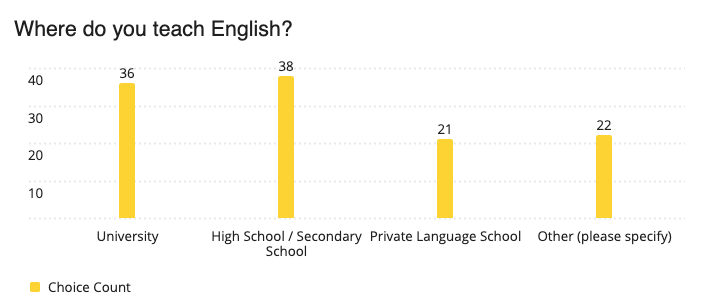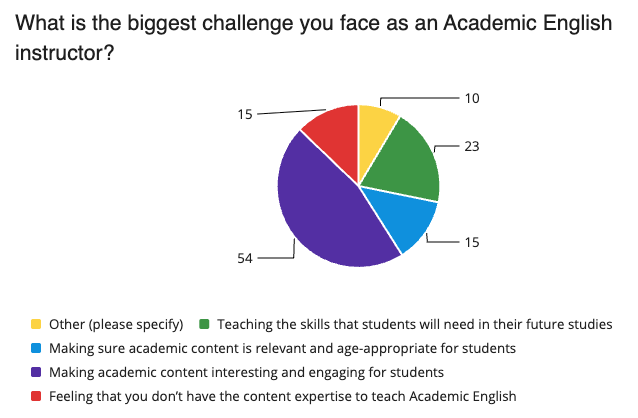On October 16th, I gave a webinar for National Geographic Learning on the topic of Academic English. (If you missed it, there’s a link to the recording at the end of this post). The number of teachers who attended indicated interest in this field of English language teaching. We also ran a small survey leading up to the webinar to gain insights into the challenges that come with teaching Academic English in 2025. Over 100 educators from around the world have responded. Here is what we found most interesting from the results.
Where Academic English is being taught
You’d expect that the majority of Academic English teachers would be found in universities. They’re likely to be teaching pre-sessional courses to support students about to take undergraduate or graduate studies or even to provide ongoing support. About a third of the teachers who responded to our survey work in universities. A more surprising result—to me—was that another third of the respondents work in high schools and secondary schools. In which case, it’s interesting to consider what type(s) of academic English is being taught in these two very different contexts.
English for Academic Purposes: EGAP or ESAP?
Given that around a third of the survey respondents reported they taught academic English in high schools or secondary schools, we can assume that many of these teachers teach what is sometimes referred to as ‘English for General Academic Purposes’ or EGAP. That’s because learners in this age range (15 to 18) haven’t started a subject specialism yet. Instead, they usually follow a General English syllabus with an emphasis on the four skills, plus EAP skills such note-taking and critical thinking in preparation for their future academic studies.
Having said that, it’s also unlikely that the respondents from universities only teach the more subject-specialist form of EAP sometimes referred to as ‘English for Specific Academic Purposes’ (or ESAP). In fact, only one respondent in the survey raised the issue of how challenging teaching English can be for individual subjects like math and science. Instead, most of our university-based respondents also commented and asked questions about more generic university-level academic skills such as researching and writing, giving presentations, listening to lectures, and participating in seminars. In other words, the majority of EAP teachers are more involved in EGAP than ESAP.
The biggest challenge is student engagement
The next part of our survey asked EAP teachers to share their biggest challenge. Overwhelmingly, the response was that “Making academic content interesting and engaging” presented the biggest challenge. Given that 50% of the respondents chose this challenge, we explored it in my webinar. When I asked how teachers typically engage students in their General English lessons, participants provided a range of answers in the chat box, for example, quizzes, discussion questions, songs, pictures, videos, surveys, and games. There was no shortage of ideas. Which raises the question: Why do we have a bigger challenge with engagement in an EAP lesson? Is it that we feel we need to be more “serious” the whole time?
Building on what we do in General English
I’d question the assumption that Academic English needs to be more “formal” and “serious.” I’ve used quizzes and images with EAP students. I’ve even used one or two songs. As long as students see the connection with the lesson as a whole, why not? In addition, I think EAP offers us a greater opportunity to engage students because often the topics are about someone who has carried out an experiment, some research, or a survey into a human topic. With such studies, it’s often possible to have students try out the experiment themselves or simulate the survey with their classmates. In the recording from the webinar, you can watch this approach in action as I use pictures and a video to report on an academic study into how we make instant decisions about people from their photos alone.
“[Academic English] can be boring and seem overwhelming to students who had felt their English levels were high in General English.”
-Survey respondent
Other concerns and solutions
As well as lack of student engagement, teachers expressed additional concerns on a wide range of issues. There were too many to address in a one-hour webinar, but we had time to focus on two other concerns from the survey.
The first was on reading skills and reading texts. In particular, the challenge of making long reading texts more accessible, and how to deal with technical and potentially boring skills such as writing references and citations. In the webinar, you can see some of my practical suggestions and solutions to these difficulties.
“Technologies have evolved so much that it’s difficult to get students engaged with only class books.”
-Survey respondent
The second challenge was on the integration of AI into EAP classes. I presented my viewpoint, which is that students can make use of AI but that we—as teachers—should show them how to use it responsibly in their learning. For example, if they are brainstorming ideas, they should come up with their own first and then ask an AI tool like ChatGPT for its ideas. In this way, they can compare and expand their thinking. Similarly, it they are preparing images or slides for a presentation, they might ask a took like Gemini to create an image, but they should source where the image came from.
The session ended with some references and further reading ,which you will also find at the end of my webinar. Watch the webinar recording here.
If you took part in our survey, we’d like to thank you on behalf of National Geographic Learning for your time and interest.
If you’ve read this post and you teach Academic English, do you have similar challenges and concerns? Feel free to share in the comments!




